Taped Tips | Difficulties Should Be Desirable
I’m actually not a big fan of the term “drills”, but I don’t have a better word for it. I don’t like it for several reasons:
One, because we aren’t “drilling” anything in. Despite the popular belief, that’s not actually how learning works. Performance, maybe, but not learning. And in my book, these “drills” are for learning.
Two, there are just too many coaches who assume that harder equals better. They just keep stacking difficulties onto their drills as if those difficulties are all going to make you better at climbing. Now we see climbers bouncing one-legged on a Bosu ball balanced on a slackline while blindfolded and miming rose moves because…
WHY?
Yeah, I don’t know either. And today, we’re going to talk about why that might not be the best solution.
Yes, of course drills should be difficult. If they aren’t challenging, there’s no reason for the athlete to adapt. But those difficulties? They should be desirable.
'Desirable difficulties’ is a term coined in 1994 by UCLA psychologist Robert Bjork. And honestly, I don’t much care about the specifics that Bjork laid out in his traditional information-processing approach; the principles of the idea are solid even if the underlying theory might be flawed. And this term is one I like.
Bjork’s research underlined the idea that the difficulties of a task should be such that they help the learner translate the skill to performance. If we – as coaches, as designers of the learning environment – keep perception coupled to action, then we are headed in the right direction.
So, balancing one-legged on a Bosu ball on a slackline may not be the way.
Instead, the difficulties we add to our drills should be a little more like climbing. The athletes should have to respond to a climbing situation.
No, I’m not a fan of the bitter washed-up 90’s climbers who claim crimp-laddering is the only form of real climbing, with bigger reaches and smaller holds being the pinnacle of progression.
There are so many other, better ways to add difficulty.
We can find creative ways to increase the tension required, the anxiety produced, – and yes, the balance needed – without uncoupling a climbing movement from having an actual climbing component. We can challenge belief, confidence, trajectory, technical skills – and literally any other facet of climbing – in a desirable, coupled way. To do that, we have to create a situation that the climber will perceive and then act upon, using a solution that will be useful for them to learn.
See, the balance required to not fall off of an unstable surface like a Bosu ball or slackline – nevermind the two in tandem – is not the same as the balance required to shift your weight and find stability over a tiny NOT-shifting foothold. What the athlete perceives in that situation – what they are reacting to – is entirely different.
Instead, the tried-and-true no-hands slab climb, or even one-handed climbing, will likely lead the climber into finding the spot where they are stable over their feet in order to make progress while exploring the movement solutions space ON THE WALL. In this case, the perception is specific to the goal, and so then is the action.
The difficulty is desirable – not just difficult.
So if you think the slackline is fun, or the Bosu ball is your favorite implement in the gym, then by all means, use them.
Have fun.
But just stop assuming that they’ll improve your climbing. Because THAT is even more unlikely than getting the right pizza on an October Saturday night at Miguels.
In our Coaching for Mastery course, we go DEEP into how coaches and climbers can create an effective practice. That’s literally what the entire course is about. The research, the theories, my experience, and how you can practically apply it. Click the image above to learn more.























A better way to view grades and progression?